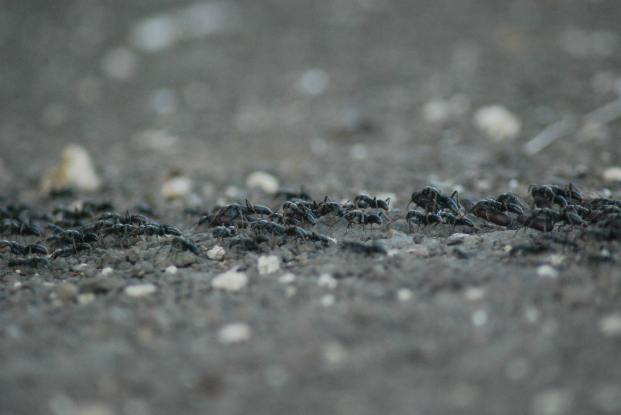These large black ants with highly functioning eye sight come in 2 sizes, 10mm and 17 mm. This may be an adaptation for accessing tunnels of different sizes. They are known for their raiding parties which they launch on termite nests. They live in colonies of between 400 and 1,400.
Seven amazing Matabele ant facts
- When raiding a termite nest the Matabele ant will use their sting to paralyse the termites. They then drag them to the surface and pile them up. Once the hunt is over the ants will carry their prey back to their own nest. The larger ants can carry up to 12 termites at a time.
- Even outside of the nest Matabele ants will work cooperatively with each another in self-defence, they have been known to turn back to rescue one another.
- When a column of Matabele ants is disturbed they emit a hissing sound to intimidate the aggressor.
- Rather than raiding a termite colony to extinction the Matabele ants will sustainably hunt so that they can return time and time again.
- Preying almost exclusively on termites, Matabele ants launch raiding parties of up to 1,000 strong. These raids are conducted in columns of ants marching 2 to 10 abreast, with the column reaching up to 1.5 m in length.
- Matabele ants are named after the Matabele tribe which originated in Zimbabwe, a splinter group of the Zulu. They were fierce fighters mounting raids on other tribes during the 1800s.
- Matabele ants will send out a scout in search of a termite nest. Once one is located, usually within 95 m of the ants own nest, the scout will return laying a chemical trail. The raiding party then follows this to their quarry.
Vote for the fact you find most fascinating
Even outside of the nest Matabele ants will work cooperatively with each another in self-defence, they have been known to turn back to rescue one another.
When raiding a termite nest the Matabele ant will use their sting to paralyse the termites. They then drag them to the surface and pile them up. Once the hunt is over the ants will carry their prey back to their own nest. The larger ants can carry up to 12 termites at a time.
Preying almost exclusively on termites, Matabele ants launch raiding parties of up to 1,000 strong. These raids are conducted in columns of ants marching 2 to 10 abreast, with the column reaching up to 1.5 m in length.
Rather than raiding a termite colony to extinction the Matabele ants will sustainably hunt so that they can return time and time again.
When a column of Matabele ants is disturbed they emit a hissing sound to intimidate the aggressor.
Matabele ants will send out a scout in search of a termite nest. Once one is located, usually within 95 m of the ants own nest, the scout will return laying a chemical trail. The raiding party then follows this to their quarry.
Matabele ants are named after the Matabele tribe which originated in Zimbabwe, a splinter group of the Zulu. They were fierce fighters mounting raids on other tribes during the 1800s.



